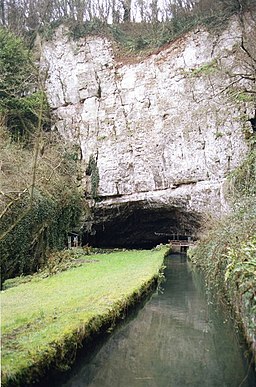River Axe (Bristol Channel)
| River Axe | |
| River | |
|
The Axe emerging from the limestone at Wookey Hole Caves
|
|
| Country | England |
|---|---|
| County | Somerset |
| District | Somerset Levels |
| Tributaries | |
| - left | Mark Yeo |
| - right | Lox Yeo River, Cheddar Yeo |
| Cities | Wookey, Henton |
| Landmarks | Wookey Hole Caves, Panborough Moor, Knowle Moor, Uphill Cliff |
| Source | Mendip Hills |
| - location | Wookey Hole Caves, Mendip, Somerset, England |
| - coordinates | 51°13′41″N 2°40′17″W / 51.22806°N 2.67139°W |
| Mouth | Weston Bay |
| - location | Brean Down, Sedgemoor, Somerset, England |
| - coordinates | 51°19′15″N 2°59′34″W / 51.32083°N 2.99278°WCoordinates: 51°19′15″N 2°59′34″W / 51.32083°N 2.99278°W |
The River Axe is a river in South West England. The river is formed by water entering swallets in the limestone and rises from the ground at Wookey Hole Caves in the Mendip Hills in Somerset, and runs through a V-shaped valley. The geology of the area is limestone and the water reaches Wookey Hole in a series of underground channels that have eroded through the soluble limestone. The river mouth is in Weston Bay on the Bristol Channel.
The river was navigable from the middle ages until 1915, and used for international trade.
The River Axe is formed by the water entering the cave systems and flows through the third and first chambers, from which it flows to the resurgence, through two sumps 40 metres (130 ft) and 30 metres (98 ft) long, where it leaves the cave and enters the open air. It is the second largest resurgence on Mendip, with an estimated catchment area of 46.2 square kilometres (17.8 sq mi), and an average discharge of 789 litres (174 imp gal; 208 US gal) per second. Some of the water is allogenic in origin i.e. drained off non-limestone rocks, collecting as streams on the surface before sinking at or near the Lower Limestone Shale — Black Rock Limestone boundary, often through swallets such as plantation swallet near St Cuthbert's lead works between the Hunter's Lodge Inn and Priddy Pools. It then passes through major cave systems such as Swildon's Hole, Eastwater Cavern and St Cuthbert's Swallet, around Priddy, but 95% is water that has percolated directly into the limestone.
...
Wikipedia

